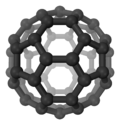Buckminsterfullerene
| |||
| Names | |||
|---|---|---|---|
| IUPAC name
(C60-Ih)[5,6]fullerene
| |||
| Other names
Buckyball; Fullerene-C60; [60]fullerene
| |||
| Identifiers | |||
3D model (JSmol)
|
|||
| 5901022 | |||
| ChEBI | |||
| ChemSpider | |||
| ECHA InfoCard | 100.156.884 | ||
PubChem CID
|
|||
CompTox Dashboard (EPA)
|
|||
| |||
| |||
| Properties | |||
| C60 | |||
| Molar mass | 720.660 g·mol−1 | ||
| Appearance | Dark needle-like crystals | ||
| Density | 1.65 g/cm3 | ||
| Melting point | sublimates at ~600 °C[1] | ||
| insoluble in water | |||
| Structure | |||
| Face-centered cubic, cF1924 | |||
| Fm3m, No. 225 | |||
a = 0.14154 nm
| |||
Except where otherwise noted, data are given for materials in their standard state (at 25 °C [77 °F], 100 kPa).
| |||
| Part of a series of articles on |
| Nanomaterials |
|---|
 |
| Carbon nanotubes |
| Fullerenes |
| Other nanoparticles |
| Nanostructured materials |
Buckminsterfullerene (or buckyball) is a spherical fullerene molecule with the formula C60. It is a cage-like fused-ring structure (Truncated icosahedron) which resembles a soccer ball, made of twenty hexagons and twelve pentagons, with a carbon atom at the vertices of each polygon and a bond along each polygon edge.
It was first intentionally prepared in 1985 by Harold Kroto, James R. Heath, Sean O'Brien, Robert Curl and Richard Smalley at Rice University.[2] Kroto, Curl and Smalley were awarded the 1996 Nobel Prize in Chemistry for their roles in the discovery of buckminsterfullerene and the related class of molecules, the fullerenes. The name is an homage to Buckminster Fuller, as C60 resembles his trademark geodesic domes. Buckminsterfullerene is the most common fullerene molecule in terms of natural occurrence, as it can be found in small quantities in soot.[3][4] Solid and gaseous forms of the molecule have been detected in deep space.[5]
Buckminsterfullerene is the largest matter to have been shown to exhibit wave–particle duality.[6] Its discovery led to the exploration of a new field of chemistry, involving the study of fullerenes.
Etymology
Buckminsterfullerene's name derives from the name of the noted futurist and inventor Buckminster Fuller. One of his designs of a geodesic dome structure bore a great resemblance to C60; as a result, the discoverers of the allotrope named the newfound molecule after him. The general public, however, sometimes refers to buckminsterfullerene, and even Mr. Fuller's dome structure, as buckyballs.[7]
History
The serendipitous discovery of a third allotropic form of carbon in 1985, uncovered a fundamentally different structure of closed carbon cages, eventually becoming known as fullerenes. This new family of non-planar carbon compounds generated immense interest within the scientific community in a short period of time, with thousands of papers published about fullerenes and fullerene-based materials in the 1990s.
Discovery

Theoretical predictions of buckyball molecules appeared in the late 1960s – early 1970s,[8] but they went largely unnoticed. In the early 1970s, the chemistry of unsaturated carbon configurations was studied by a group at the University of Sussex, led by Harry Kroto and David Walton. In the 1980s a technique was developed by Richard Smalley and Bob Curl at Rice University, Texas to isolate these substances. They used laser vaporization of a suitable target to produce clusters of atoms. Kroto realized that by using a graphite target,[9] any carbon chains formed could be studied.
C60 was discovered in 1985 by Robert Curl, Harold Kroto and Richard Smalley. Using laser evaporation of graphite they found Cn clusters (where n>20 and even) of which the most common were C60 and C70. For this discovery they were awarded the 1996 Nobel Prize in Chemistry. The discovery of buckyballs was quite surprising, as the scientists aimed the experiment at producing carbon plasmas to replicate and characterize unidentified interstellar matter. Mass spectrometry analysis of the product indicated the formation of spheroidal carbon molecules.[8]
The experimental evidence, a strong peak at 720 atomic mass units, indicated that a carbon molecule with 60 carbon atoms was forming, but provided little structural information. The research group concluded after reactivity experiments, that the most likely structure was a spheroidal molecule. The idea was quickly rationalized as the basis of an icosahedral symmetry closed cage structure. Kroto mentioned geodesic dome structures of the noted futurist and inventor Buckminster Fuller as influences in the naming of this particular substance as buckminsterfullerene.[8]
Further developments
The versatility of fullerene molecules has led to a great deal of research exploring their properties. One potentially useful property is its large capacity internal spaces that atoms of different elements may be placed inside the molecular cage formed by the carbon atoms, producing a shrink-wrapped version of these elements.[10]
Beam-experiments conducted between 1985 and 1990 provided more evidence for the stability of C60 as well as supporting the closed cage structural theory and predicting some of the bulk properties such a molecule would have. Around this time, intense theoretical group theory activity also predicted that C60 should have only four IR active vibrational bands, on account of its icosahedral symmetry.[11]
In 1989 the Heidelberg/Tucson group, led by physicists Wolfgang Krätschmer and Donald Huffman, had observed unusual optical absorptions in thin carbon films produced by arc-processed graphite rods. Among other features, the IR spectra showed four discrete bands in close agreement to those proposed for C60. A paper published by the group in 1990 followed on from their thin film experiments, and detailed the extraction of a benzene soluble material from the arc-processed graphite. This extract had crystal and X-ray analysis consistent with arrays of spherical C60 molecules, approximately 0.7 nm in diameter.[11]
Synthesis

In 1990, W. Krätchmer and D. R. Huffman's developed a simple and efficient method of producing fullerenes in gram and even kilogram amounts which boosted the fullerene research. In this technique, carbon soot is produced from two high-purity graphite electrodes by igniting an arc discharge between them in an inert atmosphere (helium gas). Alternatively, soot is produced by laser ablation of graphite or pyrolysis of aromatic hydrocarbons. Fullerenes are extracted from the soot using a multistep procedure. First, the soot is dissolved in appropriate organic solvents. This step yields a solution containing up to 75% of C60, as well as other fullerenes. These fractions are separated using chromatography.[12] Generally, the fullerenes are dissolved in hydrocarbon or halogenated hydrocarbon and separated using alumina columns. [13]
Properties
Molecule
The structure of a buckminsterfullerene is a truncated icosahedron with 60 vertices and 32 faces (20 hexagons and 12 pentagons where no pentagons share a vertex) with a carbon atom at the vertices of each polygon and a bond along each polygon edge. The van der Waals diameter of a C
60 molecule is about 1.01 nanometers (nm). The nucleus to nucleus diameter of a C
60 molecule is about 0.71 nm. The C
60 molecule has two bond lengths. The 6:6 ring bonds (between two hexagons) can be considered "double bonds" and are shorter than the 6:5 bonds (between a hexagon and a pentagon). Its average bond length is 0.14 nm. Each carbon atom in the structure is bonded covalently with 3 others.[14]
The C60 molecule is extremely stable, being able to withstand high temperatures and pressures. The exposed surface of the structure is able to react with other species while maintaining the spherical geometry.[15] The hollow structure is also able to entrap atoms and small molecules, which do not react with the fullerene molecule.
C60 can undergo six reversible, one-electron reductions to C606−
, whereas oxidation is irreversible. The first reduction requires is ~1.0 V (Fc/Fc+
), indicating that C60 is an electron acceptor. C60 has a tendency of avoiding having double bonds within the pentagonal rings which makes electron delocalization poor, and results in the fact that C60 is not "superaromatic". C60 behaves very much like an electron deficient alkene and readily reacts with electron rich species.[11]
A carbon atom in the C60 molecule can be substituted by a nitrogen or boron atom yielding a C59N or C59B respectively.[16]
| Centered by | Vertex | Edge 5-6 |
Edge 6-6 |
Face Hexagon |
Face Pentagon |
|---|---|---|---|---|---|
| Image | 
|
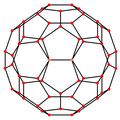
|
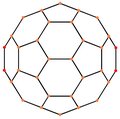
|
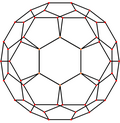
|

|
| Projective symmetry |
[2] | [2] | [2] | [6] | [10] |
Solution
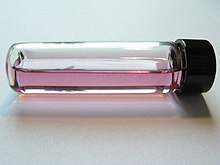
| Solvent | S |
|---|---|
| 1-chloronaphthalene | 51 |
| 1-methylnaphthalene | 33 |
| 1,2-dichlorobenzene | 24 |
| 1,2,4-trimethylbenzene | 18 |
| tetrahydronaphthalene | 16 |
| carbon disulfide | 8 |
| 1,2,3-tribromopropane | 8 |
| xylene | 5 |
| bromoform | 5 |
| cumene | 4 |
| toluene | 3 |
| benzene | 1.5 |
| carbon tetrachloride | 0.447 |
| chloroform | 0.25 |
| n-hexane | 0.046 |
| cyclohexane | 0.035 |
| tetrahydrofuran | 0.006 |
| acetonitrile | 0.004 |
| methanol | 0.00004 |
| water | 1.3×10−11 |
| pentane | 0.004 |
| octane | 0.025 |
| isooctane | 0.026 |
| decane | 0.070 |
| dodecane | 0.091 |
| tetradecane | 0.126 |
| dioxane | 0.0041 |
| mesitylene | 0.997 |
| dichloromethane | 0.254 |
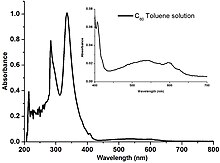
Fullerenes are sparingly soluble in many aromatic solvents such as toluene and others like carbon disulfide, but not in water. Solutions of pure C60 have a deep purple color which transforms into brown upon drying off the solvent. The reason for this color change is the relatively narrow energy width of the band of molecular levels responsible for green light absorption by individual C60 molecules. Thus individual molecules transmit some blue and red light light resulting in a purple color. Upon drying, intermolecular interaction results in the overlap and broadening of the energy bands, thereby eliminating the blue light transmittance and causing the purple to brown color change.[20]
Solubility of C60 in some solvents shows unusual behavior due to existence of solvate phases (analogues of crystallohydrates). For example, solubility of C60 in benzene solution shows maximum at about 313 K. Crystallization from benzene solution at temperatures below maximum results in formation of triclinic solid solvate with four benzene molecules C60·4C6H6 which is rather unstable in air. Out of solution, this structure decomposes into usual fcc C60 in a few minutes. At temperatures above solubility maximum the solvate is not stable even when immersed in saturated solution and melts with formation of fcc C60. Crystallization at temperatures above the solubility maximum results in formation of pure fcc C60. Millimeter-sized crystals of C60 and C70 can be grown from solution both for solvates and for pure fullerenes.[21][22]
Solid
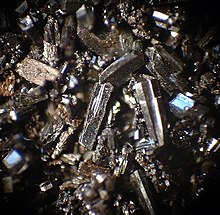

In a solid, buckminsterfullerene molecules normally stick together via the van der Waals forces; however, exposure to light or oxygen can result in their dimerization and polymerization. At low temperatures they are arranged in a simple cubic structure and locked against rotation. Upon heating, they start rotating at about −20 °C that results in a first-order phase transition to a face-centered cubic (fcc) structure and a small, yet abrupt increase in the lattice constant from 0.1411 to 0.14154 nm.[23]
C60 solid is as soft as graphite, but when compressed to less than 70% of its volume it transforms into a superhard form of diamond (see aggregated diamond nanorod). C60 films and solution have strong non-linear optical properties, particularly, their optical absorption increases with the light intensity (saturable absorption).
C60 forms a brownish solid with an optical absorption threshold at ~1.6 eV.[24] It is an n-type semiconductor with a low activation energy of 0.1–0.3 eV; this conductivity is attributed to intrinsic or oxygen-related defects.[25] The unit cell of solid C60 contains voids at 4 octahedral and 12 tetrahedral sites. They are large enough (0.6 and 0.2 nm respectively) to accommodate impurity atoms. When electron-donating elements, such as alkali or other metals, are doped into these voids, C60 converts from a semiconductor into a conductor or even superconductor.[23][26]
Band structure and superconductivity

In 1991, Haddon et al.[27] found that intercalation of alkali-metal atoms in solid C60 leads to metallic behavior.[28] In 1991, it was revealed that potassium-doped C60 becomes superconducting at 18 K.[29] This was the highest transition temperature for a molecular superconductor. Since then, superconductivity has been reported in fullerene doped with various other alkali metals.[30][31] It has been shown that the superconducting transition temperature in alkaline-metal-doped fullerene increases with the unit-cell volume V.[32][33] As caesium forms the largest alkali ion, caesium-doped fullerene is an important material in this family. Recently, superconductivity at 38 K has been reported in bulk Cs3C60,[34] but only under applied pressure. The highest superconducting transition temperature of 33 K at ambient pressure is reported for Cs2RbC60.[35]
The increase of transition temperature with the unit-cell volume had been believed to be evidence for the BCS mechanism of C60 solid superconductivity, because inter C60 separation can be related to an increase in the density of states on the Fermi level, N(εF). Therefore, there have been many efforts to increase the interfullerene separation, in particular, intercalating neutral molecules into the A3C60 lattice to increase the interfullerene spacing while the valence of C60 is kept unchanged. However, this ammoniation technique has revealed a new aspect of fullerene intercalation compounds: the Mott transition and the correlation between the orientation/orbital order of C60 molecules and the magnetic structure.[36]

The C60 molecules compose a solid of weakly bound molecules. The fullerites are therefore molecular solids, in which the molecular properties still survive. The discrete levels of a free C60 molecule are only weakly broadened in the solid, which leads to a set of essentially nonoverlapping bands with a narrow width of about 0.5 eV.[28] For an undoped C60 solid, the 5-fold hu band is the HOMO level, and the 3-fold t1u band is the empty LUMO level, and this system is a band insulator. But when the C60 solid is doped with metal atoms, the metal atoms give electrons to the t1u band or the upper 3-fold t1g band.[37] This partial electron occupation of the band may lead to metallic behavior. However, A4C60 is an insulator, although the t1u band is only partially filled and it should be a metal according to band theory.[38] This unpredicted behavior may be explained by the Jahn-Teller effect, where spontaneous deformations of high-symmetry molecules induce the splitting of degenerate levels to gain the electronic energy. The Jahn-Teller type electron-phonon interaction is strong enough in C60 solids to destroy the band picture for particular valence states.[36]
A narrow band or strongly correlated electronic system and degenerated ground states are important points to understand in explaining superconductivity in fullerene solids. When the inter-electron repulsion U is greater than the bandwidth, an insulating localized electron ground state is produced in the simple Mott-Hubbard model. This explains the absence of superconductivity at ambient pressure in caesium-doped C60 solids.[34] Electron-correlation-driven localization of the t1u electrons exceeds the critical value, leading to the Mott insulator. The application of high pressure decreases the interfullerene spacing, therefore caesium-doped C60 solids turn to metallic and superconducting.
A fully developed theory of C60 solids superconductivity is still lacking, but it has been widely accepted that strong electronic correlations and the Jahn-Teller electron-phonon coupling[39] produce local electron-pairings that show a high transition temperature close to the insulator-metal transition.[40]
Chemical Reactions and properties
Hydrated fullerene (HyFn)
Hydrated fullerene C60HyFn is a stable, highly hydrophilic, supra-molecular complex consisting of С60 fullerene molecule enclosed into the first hydrated shell that contains 24 water molecules: C60@(H2O)24. This hydrated shell is formed as a result of donor-acceptor interaction between lone-electron pairs of oxygen, water molecules and electron-acceptor centers on the fullerene surface. Meanwhile, the water molecules which are oriented close to the fullerene surface are interconnected by a three-dimensional network of hydrogen bonds. The size of C60HyFn is 1.6–1.8 nm. The maximal concentration of С60 in the form of C60HyFn achieved by 2010 is 4 mg/mL.[41] [42][43][44]
Hydrogenation
C60 exhibits a small degree of aromatic character, but it still reflects localized double and single C-C bond characters. Therefore C60 can undergo addition with hydrogen to give polyhydrofullerenes. C60 also undergoes Birch reduction. For example, C60 reacts with lithium in liquid ammonia, followed by tert-butanol to give a mixture of polyhydrofullerenes such as C60H18, C60H32, C60H36, with C60H32 being the dominated product. These mixture of polyhydrofullerenes can be re-oxidized by 2,3-Dichloro-5,6-dicyano-1,4-benzoquinone to give C60 again.
Selective hydrogenation method exists. Reaction of C60 with 9,9',10,10'-dihydroanthracene under the same conditions, depending on the time of reaction, gives C60H32 and C60H18 respectively and selectively.[45]
Halogenation
Addition of fluorine, chlorine, and bromine occurs for C60.
For fluorine, the F atoms are small enough for a 1,2-addition. However, for Cl2 and Br2, the halogen atoms adds to remote C atoms due to steric factors. For example, in C60Br8 and C60Br24, the Br atoms are in 1,3- or 1,4-positions with respect to each other.
Under various conditions, a vast number of halogenated derivatives of C60 can be produced, some with extraordinary selectivity on one or two isomers over the other possible ones.
Addition of fluorine and chlorine usually results in a flattening of the C60 framework into a drum-shaped molecule. [45]
Addition of oxygen atoms
Bubbling oxygen gas into a benzene solution of C60 under certain conditions yields a C60O, an epoxide. Ozonation of C60 in 1,2-xylene at 257K gives an intermediate ozonide C60O3, which can be decomposed into 2 forms of C60O. Decomposition of C60O3 at 296K gives the epoxide, but photolysis gives a product in which the O atom bridges a 5,6-edige.[45]

Cycloadditions
The Diels-Alder reaction is commonly employed to functionalize C60. Reaction of C60 with appropriate substituted diene gives the corresponding adduct.
One novel reaction reported in 2003 involves the synthesis of stable C62 derivatives from the Diels-Alder reaction between C60 and 3,6-diaryl-1,2,4,5-tetrazines. The C62 has the structure in which a four-membered ring is surrounded by four six-membered rings.

The C60 molecules can also be coupled through a [2+2] cycloaddition, giving the dumbbell-shaped compound C120. The coupling is achieved by high-speed vibrating milling of C60 with a catalytic amount of KCN. The reaction is reversible as C120 dissociates back to two C60 molecules when heated at 450 K (177 °C; 350 °F). Under high pressure and temperature, repeated [2+2] cycloaddtion between C60 results in a polymerized fullerene chains and networks. These polymers remain stable at ambient pressure and temperature once formed, and have remarkably interesting electronic and magnetic properties, such as being ferromagnetic above room temperature.[45]
Free radical reactions
Reactions of C60 with free radicals readily occur. When C60 is mixed with a disulfide RSSR, the radical C60SR• forms spontaneously upon irradiation of the mixture.
Stability of the radical species C60Y• depends largely on steric factors of Y. When tert-butyl halide is photolyzed and allowed to react with C60, a reversible inter-cage C-C bond is formed:[45]

Cyclopropanation (Bingel reaction)
Cyclopropanation (Bingel reaction) is another common method used to functionalize C60. Cyclopropanation of C60 mostly occurs at the junction of 2 hexagons due to steric factors.
The first cyclopropanation was carried out by C. Bengel, by reacting the β-bromomalonate with C60in the presence of a base. Cyclopropanation also occur readily for C60 with diazomethanes. For example, diphenyldiazomethane reacts readily with C60 to give the compound C61Ph2.[45]
Phenyl-C61-butyric acid methyl ester has been made through cyclopropanation of C60, which finds use in organic solar cells.
Redox reactions - C60 anions and cations
The LUMO in C60 is triply degenerate, with the HOMO-LUMO separation relatively small. This suggests that reduction of C60 would not be of much difficulty, leading to a series of fulleride ions, [C60]n- (n = 1-6). The mid-point potentials of 1-electron reduction of buckminsterfullerene at 213K is given in the table below:
| Reduction potential of C60 at 213K | |
|---|---|
| Half-reaction | E◌ (V) |
| C60 ⇌ C60- | -0.169 |
| C60- ⇌ C602- | -0.599 |
| C602- ⇌ C603- | -1.129 |
| C603- ⇌ C604- | -1.579 |
| C604- ⇌ C605- | -2.069 |
| C605- ⇌ C606- | -2.479 |
C60 forms a variety of charge-transfer complexes, one example is the compound [C2(NMe)2)4]+[C60]-, of which the ion [C60]- is isolated. The compound is synthesized as follows:

This compound is of much significance as it becomes ferromagnetic when it is cooled to 16K.
The fulleride ion [C60]2- has been isolated as the [K(crypt-222)]+ salt, and is paramagnetic. It is synthesized by reacting C60 with metallic potassium in toluene/DMF solution in the presence of 2.2.2-Cryptand. The most common fulleride ion, however, is [C60]3-, which its alkali metal salts are well known for their superconductivity. In M3C60 (M = Na, K, Rb), the M+ ions occupy the interstitial holes in a lattice composed of close-packed, nearly spherical C60 cages, where the C60 cages are arranged in a ccp lattice. In Cs3C60, the cages are arranged in a bcc lattice.
| Critical temperatures (Tc) of the fulleride salts M3C60 | |
|---|---|
| Salt | Tc (K) |
| Na3C60 | (non-superconductive) |
| K3C60 | 18 |
| Rb3C60 | 28 |
| Cs3C60 | 40 |
C60 is exceedingly hard to oxidize. Three reversible oxidation processes have been observed so far, by using cyclic voltammetry with ultra-dry methylene chloride and a supporting electrolyte with extremely high oxidation resistance and low nucleophilicity, such as [nBu4N][AsF6].[45]
| Reduction potentials of C60 oxidation at low temperatures | |
|---|---|
| Half-reaction | E◌ (V) |
| C60 ⇌ C60+ | +1.27 |
| C60+ ⇌ C602+ | +1.71 |
| C602+ ⇌ C603+ | +2.14 |
Which the [C60]2+ ion is very unstable, and the third process can be studied only at low temperatures.
The redox potentials of C60 can be modified supramolecularly. A dibenzo-18-crown-6 derivative of C60 has been made, featuring a voltage sensor device, with the reversible binding of K+ ion causing an anodic shift of 90mV of the first C60 reduction.
Coordination compounds
The possession of localized double bond characters of C60 allows it to donate is π-electrons to metal cations, forming coordination complexes. For example, organometallic complexes of molybdenum, tungsten, platinum, palladium, iridium and titanium with C60 have already been synthesized, either by direct addition or displacement reaction towards the corresponding metal carbonyl,
- M(CO)6 + C60 → M(η2-C60)(CO)5 + CO (M = Mo, W; in the presence of sunlight)
other alkene complexes,
- Pt(η2-C2H4)(PPh3)2 + C60 → Pt(η2-C60)(PPh3)2 + C2H4
other alkyne complexes,
- (η5-Cp)2Ti(η2-(CH3)3SiC≡CSi(CH3)3) + C60 → (η5-Cp)2Ti(η2-C60) + CH3)3SiC≡CSi(CH3)3
or some electron-deficient species.
- trans-Ir(CO)Cl(PPh3)2 + C60 → Ir(CO)Cl(η2-C60)(PPh3)2
One extraordinary iridium complex of C60 [Ir(η2-C60)(CO)Cl(Ph2CH2C6H4OCH2Ph)2] has been prepared, producing a self-complementary C60-based host in a remarkable way, in which the iridium metal center project two electron-rich 'arms', with the phenyl groups chelating adjacent C60 ligands.[46]
Fullerenes also form particularly strong complexes with porphyrins, resulting in a highly conjugated system and definite crystal network that maybe applied in porous frameworks and photovoltaic devices in the future.
Endohedral fullerenes
Metal atoms or certain small molecules such as H2 molecules can be encapsulated inside the C60 cage. These endohedral fullerenes are usually synthesized by doping in the metal atoms in an arc reactor or by laser evaporation. These methods gives low yields of endohedral fullerenes, and a better method involves the opening of the cage, packing in the atoms or molecules, and closing the opening using certain organic reactions. This method, however, is still immature and only a few species have been synthesized this way.
Endohedral fullerenes shows distinct and intriguing chemical properties that can be completely different from the encapsulated atom or molecule, as well as the fullerene itself. The encapsulated atoms have been shown to perform circular motions inside the C60 cage, and its motion has been followed by using NMR spectroscopy.[46]
See endohedral fullerene and endohedral hydrogen fullerene for details.
Applications
C60 molecules can encage and transport atoms and molecules (e.g. radioactive labels) through the human body. For instance, lanthanum carbide (LaC2), which reacts very strongly with water vapor and oxygen and rapidly degrades in air, has been successfully protected inside C60 molecules for more than six months.[10]
In the medical field, elements such as helium (that can be detected in minute quantities) can be used as chemical tracers in impregnated buckyballs. Buckminsterfullerene could also inhibit the HIV virus. The C60 molecule could block the active site in a key enzyme in the human immunodeficiency virus known as HIV-1 protease; this could inhibit reproduction of the HIV virus in immune cells. Experiments suggest that C60 incorporated with the alkali metals can possess catalytic properties resembling those of platinum.[10]
The C60 molecule can also bind large numbers of hydrogen atoms (up to one hydrogen for each carbon) without disrupting the structure. This property suggests that C60 may be a better storage medium for hydrogen than metal hydrides (currently regarded as the best material for that purpose), and hence a key factor in the development of a new class battery or even non-polluting automobiles based on fuel cells, lighter and more efficient than lead-acid batteries.[10]
The optical absorption properties of C60 match solar spectrum that favors C60-based films for photovoltaic applications. Conversion efficiencies up to 5.7% have been reported in C60-polymer cells.[47]
In April 10, 2012 a team of French and Tunisian researchers published a study claiming that oral administration of the compound to rats "almost doubled their lifespan" [48].
References
- ^ Eiji Ōsawa (2002). Perspectives of fullerene nanotechnology. Springer. pp. 275–. ISBN 978-0-7923-7174-8. Retrieved 26 December 2011.
- ^ Kroto, H. W.; Heath, J. R.; O'Brien, S. C.; Curl, R. F.; Smalley, R. E. (1985). "C60: Buckminsterfullerene". Nature. 318 (6042): 162–163. Bibcode:1985Natur.318..162K. doi:10.1038/318162a0.
- ^ Howard, Jack B.; McKinnon, J. Thomas; Makarovsky, Yakov; Lafleur, Arthur L.; Johnson, M. Elaine (1991). "Fullerenes C60 and C70 in flames". Nature. 352 (6331): 139–41. doi:10.1038/352139a0. PMID 2067575.
- ^ Howard, J; Lafleur, A; Makarovsky, Y; Mitra, S; Pope, C; Yadav, T (1992). "Fullerenes synthesis in combustion". Carbon. 30 (8): 1183. doi:10.1016/0008-6223(92)90061-Z.
- ^ Staff (22 February 2012). "Tiny 'Soccer Ball' Space Molecules Could Equal 10,000 Mount Everests". Space.com. Retrieved 23 February 2012.
- ^ Arndt, Markus; Nairz, Olaf; Vos-Andreae, Julian; Keller, Claudia; Van Der Zouw, Gerbrand; Zeilinger, Anton (1999). "Wave-particle duality of C60". Nature. 401 (6754): 680–2. Bibcode:1999Natur.401..680A. doi:10.1038/44348. PMID 18494170.
- ^ The AZo Journal of Materials Online. AZoM™.com. "Buckminsterfullerene." 2006. Retrieved Jan 4. 2011.
- ^ a b c Katz, 363
- ^ Katz, 368
- ^ a b c d Properties of Buckminsterfullerene. Ming Kai College, Hong Kong
- ^ a b c Buckminsterfullerene, C60. University of Bristol. Chm.bris.ac.uk (1996-10-13). Retrieved on 2011-12-25.
- ^ Katz, 369–370
- ^ Shriver and Atkins. Inorganic Chemistry (Fifth Edition). W. H. Freeman and Company, New York, 2010, pp 356.
- ^ Katz, 364
- ^ Buckminsterfullerene and Buckyballs – Definition, Discovery, Structure, Production, Properties and A. AZoM.com. July 15, 2006
- ^ Katz, 374
- ^ Beck, Mihály T.; Mándi, Géza (1997). "Solubility of C60". Fullerenes, Nanotubes and Carbon Nanostructures. 5 (2): 291. doi:10.1080/15363839708011993.
- ^ Bezmel'nitsyn, V.N.; Eletskii, A.V.; Okun', M.V. (1998). "Fullerenes in solutions". Physics-Uspekhi. 41 (11): 1091. Bibcode:1998PhyU...41.1091B. doi:10.1070/PU1998v041n11ABEH000502.
- ^ Ruoff, R. S.; Tse, Doris S.; Malhotra, Ripudaman; Lorents, Donald C. (1993). "Solubility of fullerene (C60) in a variety of solvents". Journal of Physical Chemistry. 97 (13): 3379. doi:10.1021/j100115a049.
- ^ M. S. Dresselhaus; G. Dresselhaus; P. C. Eklund (20 February 1996). Science of fullerenes and carbon nanotubes. Academic Press. pp. 437–. ISBN 978-0-12-221820-0. Retrieved 26 December 2011.
- ^ Talyzin, A.V. (1997). "Phase Transition C60−C60*4C6H6in Liquid Benzene". Journal of Physical Chemistry B. 101 (47): 9679. doi:10.1021/jp9720303.
- ^ Talyzin, A.V.; Engström, I. (1998). "C70 in Benzene, Hexane, and Toluene Solutions". Journal of Physical Chemistry B. 102 (34): 6477. doi:10.1021/jp9815255.
- ^ a b Katz, 372
- ^ Katz, 361
- ^ Katz, 379
- ^ Kaz, 381
- ^ Haddon, R. C.; Hebard, A. F.; Rosseinsky, M. J.; Murphy, D. W.; Duclos, S. J.; Lyons, K. B.; Miller, B.; Rosamilia, J. M.; Fleming, R. M. (1991). "Conducting films of C60 and C70 by alkali-metal doping". Nature. 350 (6316): 320. Bibcode:1991Natur.350..320H. doi:10.1038/350320a0.
- ^ a b Gunnarsson, O. (1997). "Superconductivity in fullerides". Reviews of Modern Physics. 69 (2): 575. arXiv:cond-mat/9611150. Bibcode:1997RvMP...69..575G. doi:10.1103/RevModPhys.69.575.
- ^ Hebard, A. F.; Rosseinsky, M. J.; Haddon, R. C.; Murphy, D. W.; Glarum, S. H.; Palstra, T. T. M.; Ramirez, A. P.; Kortan, A. R. (1991). "Superconductivity at 18 K in potassium-doped C60". Nature. 350 (6319): 600. Bibcode:1991Natur.350..600H. doi:10.1038/350600a0.
- ^ "Superconductivity at 28 K in Rb_{x}C_{60}". Physical Review Letters. 66: 2830. 1991. Bibcode:1991PhRvL..66.2830R. doi:10.1103/PhysRevLett.66.2830.
- ^ Chen, C.-C.; Kelty, S. P.; Lieber, C. M. (1991). "(RbxK1-x)3C60 Superconductors: Formation of a Continuous Series of Solid Solutions". Science. 253 (5022): 886–8. Bibcode:1991Sci...253..886C. doi:10.1126/science.253.5022.886. PMID 17751824.
- ^ Zhou, O.; Zhu, Q.; Fischer, J. E.; Coustel, N.; Vaughan, G. B. M.; Heiney, P. A.; McCauley, J. P.; Smith, A. B. (1992). "Compressibility of M3C60 Fullerene Superconductors: Relation Between Tc and Lattice Parameter". Science. 255 (5046): 833–5. Bibcode:1992Sci...255..833Z. doi:10.1126/science.255.5046.833. PMID 17756430.
- ^ "Pressure dependence of superconductivity in the Na_{2}Rb_{0.5}Cs_{0.5}C_{60} fulleride". Physical Review B. 59: 4439. 1999. Bibcode:1999PhRvB..59.4439B. doi:10.1103/PhysRevB.59.4439.
- ^ a b
Ganin, Alexey Y.; Takabayashi, Yasuhiro; Khimyak, Yaroslav Z.; Margadonna, Serena; Tamai, Anna; Rosseinsky, Matthew J.; Prassides, Kosmas (2008). "Bulk superconductivity at 38 K in a molecular system". Nature. 7 (5): 367. Bibcode:2008NatMa...7..367G. doi:10.1038/nmat2179. PMID 18425134.
{{cite journal}}: More than one of|pages=and|page=specified (help) - ^ Tanigaki, K.; Ebbesen, T. W.; Saito, S.; Mizuki, J.; Tsai, J. S.; Kubo, Y.; Kuroshima, S. (1991). "Superconductivity at 33 K in CsxRbyC60". Nature. 352 (6332): 222–223. Bibcode:1991Natur.352..222T. doi:10.1038/352222a0.
- ^ a b Iwasa, Y; Takenobu, T (2003). "Superconductivity, Mott Hubbard states, and molecular orbital order in intercalated fullerides". Journal of Physics: Condensed Matter. 15 (13): R495. Bibcode:2003JPCM...15R.495I. doi:10.1088/0953-8984/15/13/202.
- ^ "Electronic structure of crystalline K_{6}C_{60}". Physical Review Letters. 67: 1610. 1991. Bibcode:1991PhRvL..67.1610E. doi:10.1103/PhysRevLett.67.1610.
- ^ "Electronic structure of superconducting Ba_{6}C_{60}". Physical Review B. 47: 14657. 1993. arXiv:cond-mat/9301006. Bibcode:1993PhRvB..4714657E. doi:10.1103/PhysRevB.47.14657.
- ^ "Strong Superconductivity with Local Jahn-Teller Phonons in C_{60} Solids". Physical Review Letters. 90: 167006. 2003. Bibcode:2003PhRvL..90p7006H. doi:10.1103/PhysRevLett.90.167006. PMID 12731998.
- ^
Capone, M.; Fabrizio, M; Castellani, C; Tosatti, E (2002). "Strongly Correlated Superconductivity". Science. 296 (5577): 2634. arXiv:cond-mat/0207058. Bibcode:2002Sci...296.2364C. doi:10.1126/science.1071122. PMID 12089436.
{{cite journal}}: More than one of|pages=and|page=specified (help) - ^ Fullerene Hydration
- ^ Andrievsky, G; Klochkov, V.K.; Bordyuh, A.B.; Dovbeshko, G.I. (2002). "Comparative analysis of two aqueous-colloidal solutions of C60 fullerene with help of FTIR reflectance and UV–Vis spectroscopy". Chemical Physics Letters. 364: 8. Bibcode:2002CPL...364....8A. doi:10.1016/S0009-2614(02)01305-2.
- ^ Andrievsky, G.; Klochkov, V.; Derevyanchenko, L. (2005). "Is the C 60 Fullerene Molecule Toxic?!". Fullerenes, Nanotubes, and Carbon Nanostructures. 13 (4): 363. doi:10.1080/15363830500237267.
- ^ Andrievsky, GV; Bruskov, VI; Tykhomyrov, AA; Gudkov, SV (2009). "Peculiarities of the antioxidant and radioprotective effects of hydrated C60 fullerene nanostuctures in vitro and in vivo". Free radical biology & medicine. 47 (6): 786–93. doi:10.1016/j.freeradbiomed.2009.06.016. PMID 19539750.
- ^ a b c d e f g Catherine E. Housecroft; Alan G. Sharpe (2008). "Chapter 14: The group 14 elements". Inorganic Chemistry, 3rd Edition. Pearson. ISBN 978-0-13-175553-6.
- ^ a b Jonathan W. Steed; Jerry L. Atwood (2009). Supramolecular Chemistry, 2nd edition. Wiley. ISBN 978-0-470-51233-3.
- ^ Katz, 385 ff.
- ^ Baati, Tarek (2012). "The prolongation of the lifespan of rats by repeated oral administration of [60]fullerene". Biomaterials. 33 (19): 4936–4946. doi:10.1016/j.biomaterials.2012.03.036.
{{cite journal}}: Unknown parameter|coauthors=ignored (|author=suggested) (help); Unknown parameter|month=ignored (help)
Bibliography
- Katz, E. A. (2006). "Fullerene Thin Films as Photovoltaic Material". In Sōga, Tetsuo (ed.). Nanostructured materials for solar energy conversion. Elsevier. pp. 361–443. ISBN 978-0-444-52844-5.
External links
 Media related to Fullerenes at Wikimedia Commons
Media related to Fullerenes at Wikimedia Commons- History of C60's discovery carried out by the Chemistry Department at Bristol University
- Harold Kroto et al.'s original publication on their discovery of buckminsterfullerene, in Nature, published in 1985
- A brief overview of buckminsterfullerene described by the University of Wisconsin-Madison
- A report by Ming Kai College detailing the properties of buckminsterfullerene
- An in-depth look at buckminsterfullerene and its discovery, properties, and applications conducted by the University of Wisconsin-Madison
- Donald R. Huffman and Wolfgang Krätschmer's paper pertaining to the synthesis of C60 in Nature published in 1990
- A thorough description of C60 by the Oak Ridge National Laboratory
- An article about buckminsterfullerene on Connexions Science Encyclopaedia
- Extensive statistical data compiled by the University of Sussex on the numerical quantatative properties of buckminsterfullerene
- A web portal dedicated to buckminsterfullerene, authored and supported by the University of Bristol
- Another web portal dedicated to buckminsterfullerene, authored and supported by the Chemistry Department at the University of Bristol
- A brief article entirely devoted to C60 and its discovery, structure, production, properties, and applications
- Jack Howard's scientific report describing the synthesis of C60 with combustion research published in 2000 at the 28th International Symposium on Combustion
- American Chemical Society's complete article on buckminsterfullerene


